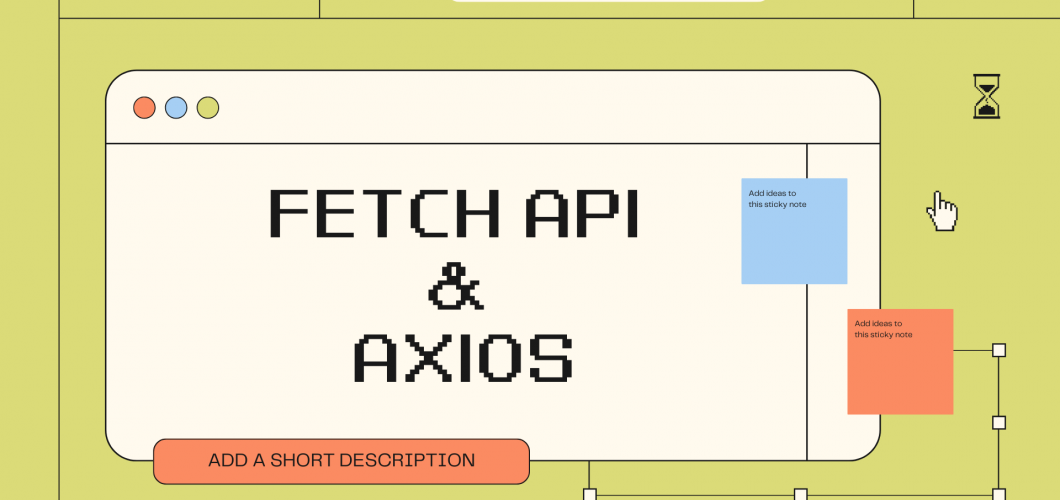
Using Fetch API and Axios in JavaScript
Introduction
In modern web development, fetching and sending data from and to the server has become a crucial task. This is typically done through HTTP requests. JavaScript provides various tools to perform asynchronous data communication, and two of the most popular tools are Fetch API and Axios.
In this article, we will explore how to make HTTP requests using Fetch API and Axios, the differences between them, and their advantages. We will also provide examples of using both methods.
What is Fetch API?
The Fetch API is a modern API used to make HTTP requests to fetch and send data in JavaScript. The fetch() function provides asynchronous data handling using Promises. The Fetch API offers a cleaner and more readable syntax compared to older methods.
Fetch API Features:
- Asynchronous: The
fetch()function returns a Promise object that handles HTTP request responses asynchronously. - Easy to Use: Fetch makes it easy to work with network requests.
- Browser Support: Modern browsers support Fetch API, but older browsers may not.
Using Fetch API
Fetching and sending data with Fetch API is straightforward. Here is the basic usage:
Getting Data (GET Request)
fetch('https://jsonplaceholder.typicode.com/posts')
.then(response => {
if (!response.ok) {
throw new Error('Network response was not ok');
}
return response.json();
})
.then(data => console.log(data))
.catch(error => console.log('There was a problem with your fetch operation:', error));
Sending Data (POST Request)
fetch('https://jsonplaceholder.typicode.com/posts', {
method: 'POST',
headers: {
'Content-Type': 'application/json'
},
body: JSON.stringify({
title: 'foo',
body: 'bar',
userId: 1
})
})
.then(response => response.json())
.then(data => console.log('Success:', data))
.catch(error => console.log('Error:', error));
What is Axios?
Axios is a library used for making HTTP requests in modern JavaScript applications. It is a Promise-based library and a more advanced version of Fetch API. Axios provides more flexibility with features like data processing, error handling, and support for multiple platforms.
Axios can run on both Node.js and the browser, making it an ideal solution for web and server-side applications.
Axios Features:
- Promise-Based: Axios uses Promises for handling HTTP requests.
- Advanced Error Handling: Axios offers more user-friendly error management.
- Automatic Data Parsing: JSON data is automatically parsed, so you don't need to manually call
.json(). - Request Cancellation: Axios allows you to cancel requests.
- More Features: Axios simplifies tasks like handling headers, sending data, and transforming responses.
Using Axios
Getting Data (GET Request)
axios.get('https://jsonplaceholder.typicode.com/posts')
.then(response => console.log(response.data))
.catch(error => console.log('There was an error!', error));
Sending Data (POST Request)
axios.post('https://jsonplaceholder.typicode.com/posts', {
title: 'foo',
body: 'bar',
userId: 1
})
.then(response => console.log('Success:', response.data))
.catch(error => console.log('Error:', error));
Fetch API vs Axios: Comparison
| Feature | Fetch API | Axios |
|---|---|---|
| Supported Browsers | Modern browsers (Internet Explorer 11 and above) | All modern browsers and Node.js |
| Data Parsing | You need to use .json() to parse JSON data | JSON data is automatically parsed |
| Error Handling | Errors are handled using .catch() | More advanced error handling with try/catch |
| HTTP Method Configuration | You configure methods, headers, and body manually | Simple and customizable configuration |
| Request Cancellation | Not supported | Request cancellation is supported |
| Response Time Transformation | Data must be manually transformed | Axios automatically transforms responses |
When to Use Fetch API and Axios: Which One to Choose?
When to Use Fetch API:
- Ideal for simpler projects or API integrations.
- If the browser supports modern features and simple GET and POST requests are sufficient, Fetch API is a good option.
When to Use Axios:
- Recommended for advanced request management or larger projects.
- If you need more features like error handling, automatic JSON parsing, or request cancellation, Axios is the better choice.
- Axios is ideal when you need support for both frontend and backend development.
Conclusion
Fetch API and Axios are two popular ways to make HTTP requests in JavaScript. Both are Promise-based and make handling asynchronous data easy. However, Axios provides more flexibility and advanced features, while Fetch API offers a simpler, minimalistic approach.
Depending on your project needs, both methods can be suitable. For smaller, simpler projects, Fetch API might be sufficient, but for larger, more complex applications, Axios's additional features may be more beneficial.

Leave a Comment